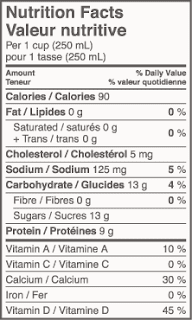

#Whole milk vs skim milk nutrition facts free#
Milk, nonfat, fluid, with added vitamin A and vitamin D (fat free or skim). Because soy milk and skim milk are low in glycemic loads, drinking them will not make your sugar levels rise. Both of them contain vitamins, riboflavin, folate, protein and calcium, which lead to better bone and muscle health. How well do plant based alternatives fare nutritionally compared to cow’s milk? Journal of Food Science and Technology. Benefits Vitamin D content of milk Bottom line When you buy a carton of milk, you may notice that some brands state on the front of the label that they contain vitamin D. Nutrition Comparison These milks are similar in several aspects. Milk also contains more vitamins, such as vitamin A, vitamin D, vitamin B2, B3, B5, and B12. In contrast, those consumers who typically drink whole milk show stronger preferences for fat in milk, as compared to those who stated a preference for whole. Milk is only a little higher in calories, protein, fats, and carbohydrates. Effect of whole milk compared with skimmed milk on fasting blood lipids in healthy adults: a 3-week randomized crossover study. Summary Low-fat milk and cultured buttermilk are very similar in their macronutrient compositions. Journal of Pediatric Gastroenterology and Nutrition. A Comparison of the Nutritional Value of Cowʼs Milk and Nondairy Beverages. A comparison of the nutritional value of cow's milk and nondairy beverages. New perspectives on dairy and cardiovascular health. One serving of dairy is equal to an 8-ounce glass of milk, a 6 or 8 ounce container of yogurt, or 1 1/2 ounces of natural cheese.Lovegrove JA, Hobbs DA. To help meet calcium requirements, the USDA Dietary Guidelines for Americans recommends 3 cups of low fat or fat free milk and dairy foods daily for those 9 years or older, 2 1/2 servings for those 4-8 years old and 2 servings for those 2-3 years old. It is difficult to obtain enough calcium without consuming milk (or other dairy foods). A diet that includes three servings of milk (or equivalent dairy foods) each day provides enough calcium and other nutrients that may help reduce the risk of osteoporosis, high blood pressure and colon cancer.

Regardless of its fat content, milk provides 8 grams of protein and about 300 milligrams of calcium per serving (8 fluid ounces). Milk is well known as an excellent source of calcium. In fact, each serving of milk provides 10% or more of the recommended daily intake for calcium, Vitamin D (if fortified), protein, pantothenic acid, Vitamin A, Vitamin B12, riboflavin, niacin, phosphorus, selenium, iodine, zinc and potassium.

Compare carbs, fat, protein, vitamins, minerals, and more between different foods or serving sizes. 149 calories 7.9 grams of total fat 4.6 grams of saturated fat 7.7 grams of protein 276 milligrams of calcium On the other hand, 1 cup of skim milk, also known as fat-free milk, contains: 83 calories 0.2 grams of total fat 0.14 grams of saturated fat 8. This means it provides a high level of essential nutrients compared to its calories. Nutrition Comparison of Whole Milk vs Skim Milk. Whole milk has 61 kcal per 100g and skimmed milk 34 kcal per 100g so. With skim milk, youre getting the key nutritional riches we expect in milk calcium, vitamin D. serving of milk provides thirteen essential nutrients, making it one of the most nutrient-dense foods. At first glance, you can see that in whole milk is much more calories than in skimmed milk. First is skim (also called fat-free or nonfat) cows milk.


 0 kommentar(er)
0 kommentar(er)
